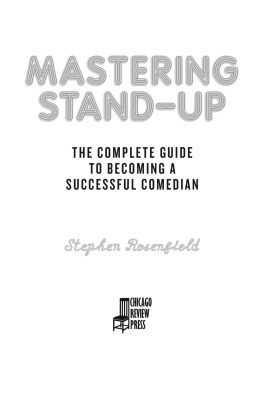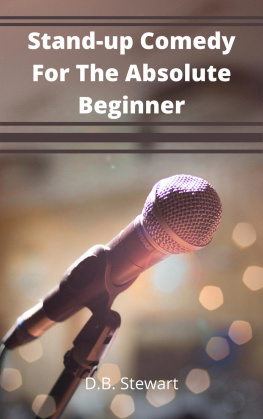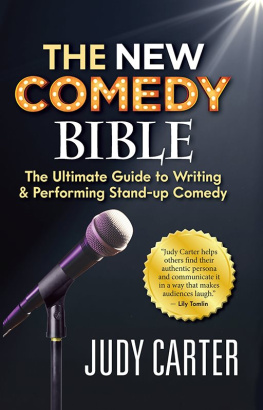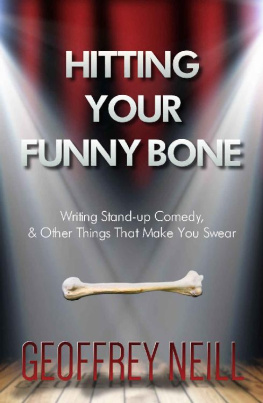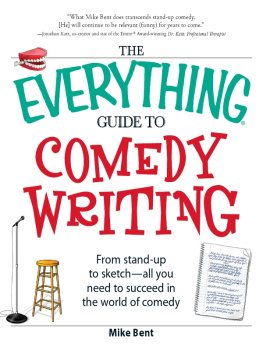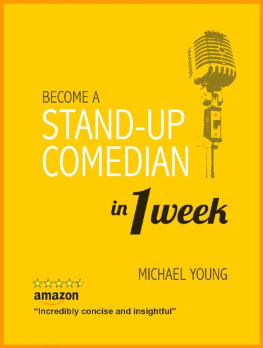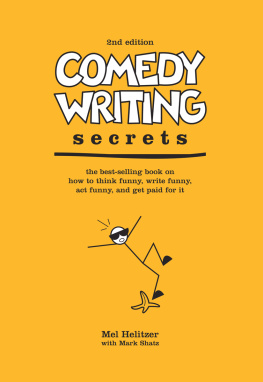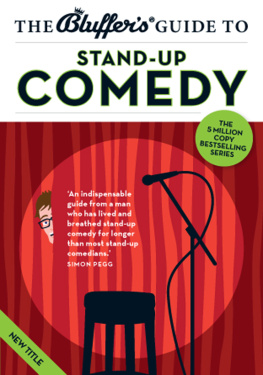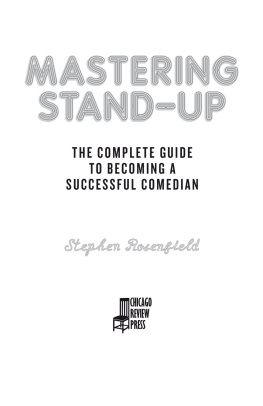To the snake in the Garden of Eden. Without this snake, humankind would lack the two absolute essentials of comedy: problems and knowledge. Adam and Eve were happy before the snake arrived and thats nice, but happiness is not funny. The laughs start when the problems start and we have knowledge of them. Its the snake that created the circumstances for laughter on Earth.
PREFACE
THE STAND-UP COMEDY EXPERIENCE STARTED FOR ME in my living room on East 58th Street in Manhattan. I was a director and writer in the theater then. One day a stand-up named Eli Krupnick came to my apartment and said he wanted to work with me. Id worked with dozens of actors to build strong, memorable performances. In my first off-Broadway show, a sketch comedy show that I directed and coauthored, our lead, Lee Wilkof, won the Obie Award for acting. In Los Angeles I had directed the revival of the Charles Strouse musical Charlie and Algernon, and our star, P. J. Benjamin, won the L.A. Weekly and Drama-Logue Awards. I had ventured into the comedy club scene with a sketch comedy group that I directed and wrote for, Rubber Feet, who became regulars at the Comic Strip. But Id never worked with a stand-up before.
I was excited by the idea, though. For as long as I can remember, I have loved stand-up comedy. Stand-ups were the reason I watched The Ed Sullivan Show. I skipped a day of high school to see Lenny Bruce perform in the East Village.
Eli and I started to work together, and after hearing of our success, other new stand-ups began arriving at my door. None of them had training as actors. So we worked together on identifying what emotions underpinned their jokes and how to play those emotions on a comedy club stage. If a joke felt weak, we would rewrite it together. I noticed that shortening the setup and the punch, making a joke less generic and more personal, and shaping jokes to fit the persona of the comedian would bring new vitality to their performances. Our work together paid off. Its easy to determine that in stand-up comedy. You get more laughs and more gigs, and you start getting paid.
Eventually Eli suggested I conduct a workshop. Ten students met with me as a class twice a week for three weeks. Additionally, I met with them individually to work on their writing. In class they tested out their material and acted as an audience for each other. After their class presentation, they received detailed feedback from me. The workshop culminated in a performance at Dont Tell Mama, the legendary cabaret on West 46th Street. Afterward I gave them notes on their performance.
At that point, there was only one other stand-up workshop in New York, and no one in the city had developed a program that would give comics the opportunity to receive instruction straight through the whole process, from writing new jokes to performing them at a club. This first workshop took place in November 1988. It was the birth of the American Comedy Institute, a comedy school for performers and writers that now draws students from all across America and around the world.
I had come to stand-up from the world of the theater, where creating entertainment takes significant amounts of time, money, and people. The results can be magical, provocative, and breathtaking. But as I began to immerse myself in the world of stand-up, I saw that one person on an empty stage could serve up equally compelling entertainment. Theater, film, and television are all technologically sophisticated mediums employed, essentially, to tell a story. Stand-ups do the same thing, but their only technological need is, if the room is big, a microphone. This fact gives stand-ups the ability to create entertainment about the present momentnow. What happened today, in the world and in their lives. The theater can do many things magnificently, but it cant do that. Increasingly for me, a comedy club was the place I could regularly go for terrific entertainment that related to me and the moment I was living in.
The first stand-ups I worked with came from all walks of life. What they had in common was a sense of humor, a desire to be onstage, and the urgent need to communicate through comedy. Through my work with them I discovered that I had a gift for helping transform funny people into comedians.
And oh, what people! Olga Namer is a young woman who was raised in an Orthodox Jewish community in Brooklyn. Her community did its utmost to shelter its children from the world beyond their religious beliefs and cultural traditions. Her familys expectation was that she would lead her life within the confines of their neighborhood. But there was a problem. Olga is funny. Very, very funny. And when someone has a powerful comic voice inside them, that comic voice pushes hard to get out. Olga came to study with me, and now she does stand-up about her struggles to break free of her upbringing and live in the secular world.
A young man named Joseph Opio came to work with me from Uganda, where he had produced, written, and performed in a TV show modeled after The Daily Show with Jon Stewart. Now hes a staff writer on The Daily Show with Trevor Noah.
A particularly dedicated student was a young man who had a well-paying job at Gray Advertising, but who had absolutely made up his mind to leave corporate life and become a stand-up. His name is Jim Gaffigan. A high school sophomore from Brooklyn came to study with me. At 16 she was writing stand-up material that was original, personal, smart, sexy, and funny. That was Lena Dunham. Zinat Pirzadeha stand-up who was raised in Iran and fled to Swedencame to America to study with me. She told me that shed received death threats from extremists in Swedish Muslim communities and from neo-Nazis. Fearing for her life, she had given up stand-up for two years. Longing to get back onstage, she faced a decision: she could allow herself to be bullied into silence for the rest of her life, or she could continue to pursue her comedy despite the dangers. She returned to the stage. Zinat risked her life to perform stand-up comedy. She is now one of Swedens leading comedians.
The stories continue and each is unique, and it has been a joy working with these talented people and seeing them grow.
Ive been moving people forward in their comedy careers for 28 years. Ive written this book because I would enjoy doing the same for you.
The book is divided into five parts. The first part contains advice I share with comedians at the outset of our working together. The second part is devoted to all the forms that stand-up comedy can take. Knowing these forms will expand your understanding of how to express yourself as a comedian. The third part is a handbook for creating stand-up comedy material. Here you will learn how to write stand-up jokes that are original, tightly written, and funny. The fourth part is the handbook for performing stand-up comedy. This part will help you become a vivid, likable, and memorable performer. The fifth part of the book is called Get Undeniably Good. This part deals with how to successfully engage in the ongoing journey to master the art and crafts of stand-up.
If this is the journey you want to take, turn the page.

